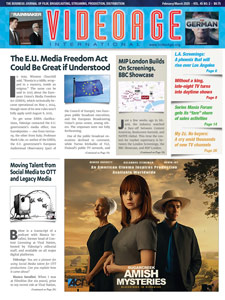Despite all the viewer complaints about limited free-to-air TV coverage of the Tokyo Olympics from global viewers, to peruse the International Olympic Committee (IOC) website, one would believe that the recent summer Games were positively record-breaking for TV stations around the world. But it is not so!
The IOC proudly boasted about the un-precedented high viewership because, it reported, “streaming platforms are breaking records, with Tokyo 2020 [held July 23-August 8, 2021] being called ‘the Streaming Games.’ NBC in the USA and Seven in Australia [are showing] their biggest digital events ever.”
In Europe, Discovery reported record audiences and engagement across its digital services. Yes, digital — which usually means a pay service — is ruling the sports roost. But at what cost to the average sports fan who is now unable to freely connect to what has traditionally been free broadcast service coverage?
Nowhere does the IOC site address the fact that free-to-air coverage hemorrhaged dramatically, meaning millions were not given the opportunity to enjoy the athletic competitions as before.
The fact that the Games even went on, despite COVID cases increasing in Tokyo (although there did not appear to be any severe increase in cases from attendees), suggests that revenues from sponsorships and digital broadcasting rights were of greater importance than the health of athletes.
Of course, the IOC requires funding for normal day-to-day operations, as well as its 20-year-old broadcast division, Olympic Broadcasting Services (OBS), which has served as the host broadcaster for every Olympic Games. There’s a permanent group of 166 people from 30 countries working out of the OBS offices in Madrid. This staff balloons to 8,100 to help deliver the actual Games broadcast worldwide.
The original intent of televising the Olympics was to allow viewers around the globe to see international athletes compete in their respective sports for free, almost as a public service. Broadcasters in many countries recouped the costs of the rights involved in relaying the Games by attracting advertisers. However, in many other countries a public broadcaster provided the service, without commercials, and had to bear the costs without such revenues.
Times have changed and so has the TV landscape. What once was free has now become anything but. Much has been written recently about the disappearing U.S. audience for NBC’s Olympics coverage from Japan, but the same has been true with other traditional terrestrial broadcasters internationally.
The BBC gave its audience incredible over-the-air coverage from the Rio 2016 and London 2012 Olympics, but this year it was only allowed to screen two live events at once along with some Red-Button (i.e., the BBC’s digital service) coverage, owing to a very complicated agreement with the Discovery Channel. By way of example at how hard the agreement hurt their viewership — the opening ceremony from Tokyo saw a 39.4 percent decline from Rio’s opening ceremony and an even more disastrous 61 percent decline from Beijing’s.
As for what caused this change we have to go back to a 2016 deal between the IOC and the U.S.’s Discovery Network for European coverage rights, valued at around a $1 billion.
The deal gave Discovery’s pay-TV service, Eurosport, and the new Discovery Plus primary screening rights to the U.K. and other European nations, meaning viewers were severely restricted to limited free coverage. This complicated agreement resulted in the BBC giving up some of its rights for the Tokyo Games, as well as settling for limited coverage of the 2022 Winter (Beijing) and the 2024 Summer Games (Paris). A new deal will be offered in 2024 but not in time to help the BBC (or other FTA broadcasters) receive better treatment for Paris.
Elsewhere, public broadcasters in France ex-perienced a 17.4 percent decline from the same period during 2016’s Rio Games and a 74 percent decline from the 2012 London Games for the first three days of the games.
Germany saw a 73 percent decline from the free-to-air TV audience that watched the opening of the Beijing Olympics and Italian viewers were up in arms about the limited coverage they received via free-to-air broadcasters.
As for the Paralympic Games that follow the Summer Olympics, in the U.K., it is a legal requirement for those Games to be broadcast live by a free-to-air broadcaster, although a pay-to-view broadcaster can share the rights.
Some past Paralympic coverage on NBC has been criticized by the Olympic organization as being less than expected, so they set the Tokyo version for around 1,200 hours all told. That said, less than 200 of those hours were scheduled for free–to-air on NBC. For the week beginning Sunday August 29, NBC afforded the Paralympics 90 minutes of coverage on Sunday morning and an hour in the evening, but nothing else until the following Saturday for one hour, for a total of about 10 hours.
All of this is only the tip of the televised sports iceberg. In recent years local sports such as football/soccer (the biggest sport in the world for players and TV audiences) have become global, with games from England, France, Germany, Spain and Italy, to name but a few, beaming into homes outside those respective countries. At first it was all part of increasing the audience. But in today’s world, audiences anywhere will be lucky to see a game over-the-air for free.
Agreed, sports rights have become phenomenally expensive to TV, and major networks around the world are unable to afford the billions it takes for, say, Premier League football (soccer) from the U.K. And the costs are rising for other sports, as well. No wonder premium pay channels and some streamers are adding sports to their rosters. Sadly, for many sports fans around the globe, the opportunity to watch their favorite sports could well end up being out of financial reach and, therefore, out of view.
How soon before U.S. viewers have to pay in order to watch other sports, such as the Super Bowl and the World Series?
Interestingly, in the U.S., college sports, Little League, lacrosse, cornhole (the bean bag game), barrel jumping, and other previously under-the-radar sports (or events, such as hot dog eating) have become increasingly visible on U.S. over-the-air TV and even some pay channels of late. How soon before we see Calcio Storico, a truly brutal form of rugby from Italy, or Motoball (football/soccer on motorbikes) regularly beside them each weekend? Well, they aren’t anywhere near the hefty price of Olympics coverage, so don’t be surprised.
No matter what they did to their free-to-air viewers, Discovery, through Discovery Plus and Eurosport, as well as NBC, via Peacock, shot themselves in the foot by depriving a good percentage of their audiences from seeing the usual broad Olympics coverage they had become used to, in order to promote their respective pay services. But it is doubtful that the lessons have been learned for the Winter Games next year, or the Summer Games in 2024.
(By Mike Reynolds)
Audio Version (a DV Works service)












Leave A Comment